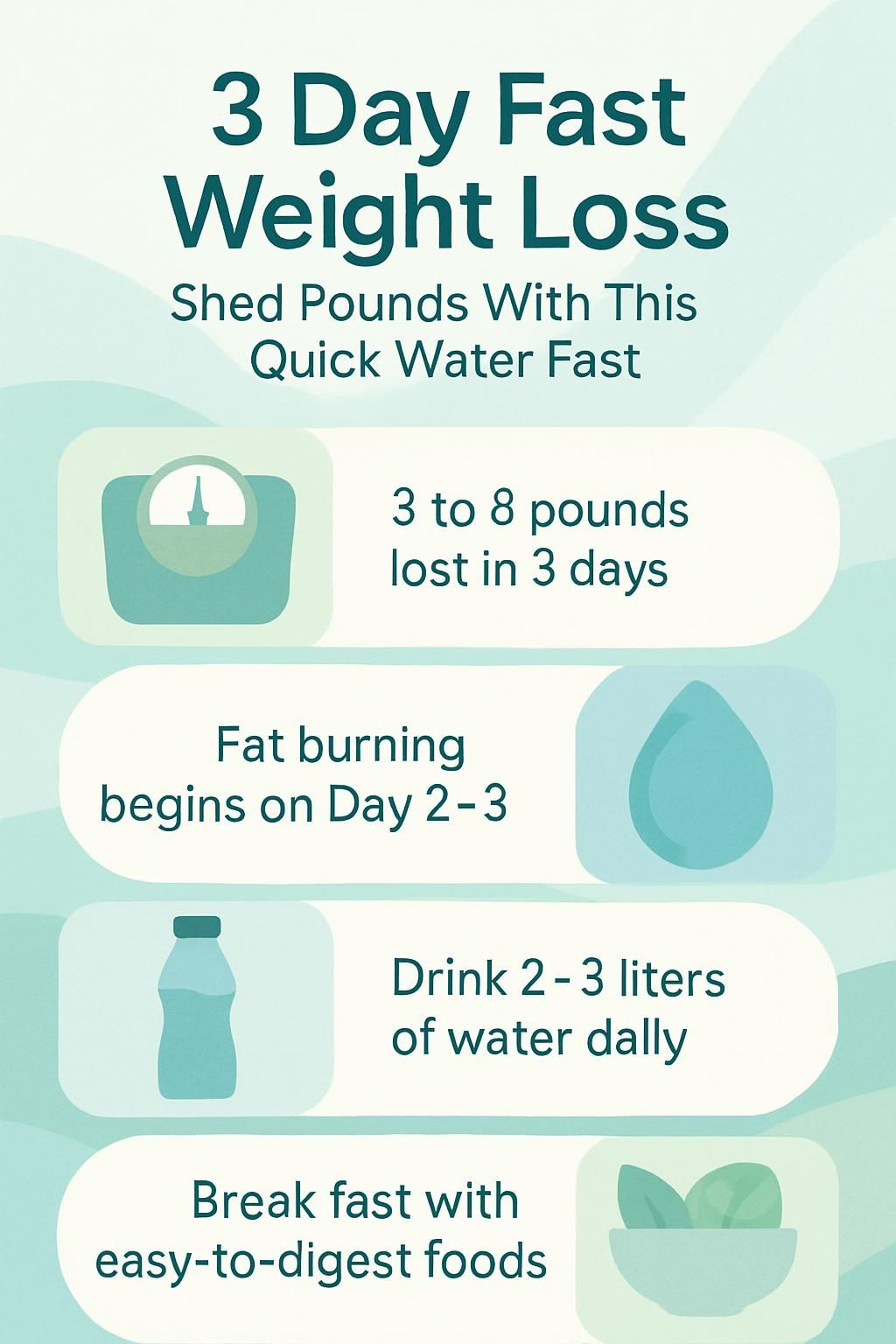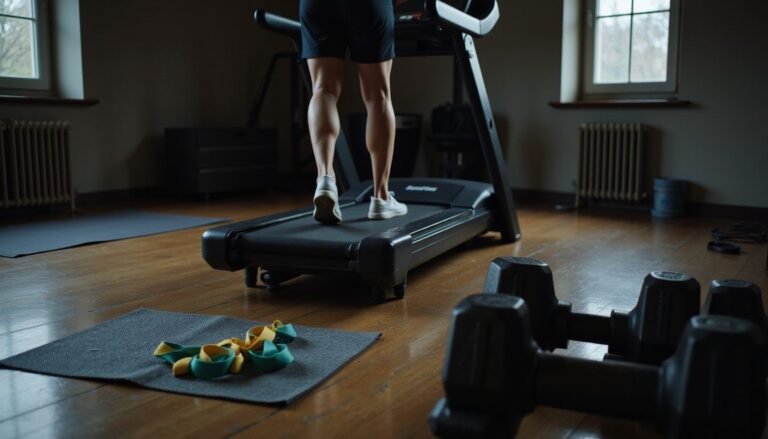3 Day Fast Weight Loss: Shed Pounds With This Quick Water Fast
Our Nutrition Assistant AI Suite will transform your body. You will lose fat, get toned, and build muscle. Gain confidence and optimal health.
Trying to drop weight fast can feel discouraging when progress stalls. A short 3-day water fast, which means drinking only water for 72 hours, is one option some people use for quick results.
Early research suggests a brief water fast can reduce water weight and kickstart fat use within days. This guide shows how a 3-day fast works, the benefits, safety steps, and what to expect each day.
Use this overview to decide if this fast fits your goals and health needs.
Key Takeaways
- A 3-day water fast can drop 3 to 8 pounds quickly, mostly from water and glycogen loss, not pure fat.
- Your body moves from using stored sugar to fat between Day 2 and Day 3, which raises ketone levels.
- Short fasts may improve focus, reduce inflammation, and enhance insulin sensitivity in small studies.
- Risks include dehydration and electrolyte issues. Aim for 2 to 3 liters of water daily and consider electrolytes.
- Health experts suggest easing into the fast, skipping hard workouts, and breaking the fast gently with broth or plain yogurt.

What Is a 3-Day Water Fast and How Does It Work?

A 3 day water fast means you consume only water for 72 hours. No food and no calorie-containing drinks. This pause in eating changes calorie intake, body weight, and how your metabolism works.
How does a 3-day water fast work step-by-step?
Day 1. You stop eating and drink only water. Your liver releases glycogen, the stored form of glucose. Hunger is common. Mild headache or fatigue can appear as your body adjusts to zero calories. Drink 2 to 3 liters of water to support hydration and normal body function.
Day 2. Glycogen runs low. Your body starts using fat for energy. This shift produces ketone bodies, which fuel the brain and muscles. Hunger may ease a bit, though energy can dip.
Day 3. Fat burning increases. Autophagy, a natural cell clean-up process, rises. The scale often shows less bloating and lower weight from both water loss and some fat loss.
During a 3 day water fast, the human body switches from burning sugar to burning fat, supporting rapid weight loss.
How does water fasting differ from other fasting methods?
Water fasting allows only water for the entire period. No coffee, tea, or food. Intermittent fasting, in contrast, sets daily eating windows, such as 16 hours fasting and 8 hours eating. Alternate day fasting allows some calories on certain days.
A low-calorie diet still includes food, though in smaller amounts. Water-only fasting creates a faster drop in blood sugar and a bigger shift in insulin sensitivity, which can raise the risk of electrolyte imbalance and dehydration.
Several clinical trials suggest intermittent fasting is easier to sustain for weight management, especially for people with chronic conditions like type 2 diabetes. The best method depends on your health history and goals.
Weight Loss Benefits of a 3-Day Water Fast
A three-day water fast creates a strong calorie deficit, which can lead to fast weight loss. Some studies suggest improved insulin resistance and a short burst of fat loss during fasting for three days.
How does a 3-day water fast create a calorie deficit?
During the fast you drink only water. Most adults need about 1,500 to 2,000 calories a day, depending on size and activity. Skipping food for three days removes roughly 4,500 to 6,000 calories.
Your body first taps carbohydrate stores. Then it breaks down fat for energy. During a supervised fast, I noticed quick scale changes, largely from this drop in calories. If your goal is lower body mass, this short window can move the needle.
Why do you lose water weight initially during fasting?
Glycogen, your stored carbohydrate, binds water. Each gram of glycogen holds about three grams of water. Early in a fast, your body burns glycogen. As it drops, the water attached to it leaves through urine and sweat.
This is why the scale falls most in the first day or two. I once saw nearly four pounds gone in 48 hours, which was mainly water. Many diets do not cause this rapid water shift, which makes fasting look faster at first.
When does the body switch to burning fat?
Once glycogen falls, insulin drops and fat oxidation increases. Fatty acids travel to the liver and become ketones, a steady fuel for many organs.
This switch often begins between 24 and 48 hours without food. My first 3-day fast brought steadier energy by day two, likely from ketones. Studies, including randomized trials, show a clear rise in ketones as this shift takes place.
How Weight Loss Occurs During a 3-Day Fast
During a 3-day water fast your body changes fuel sources. With calories at zero, body composition and metabolism shift quickly.
How do glycogen and water weight change during fasting?
Carbs are stored as glycogen in the liver and muscles. Glycogen holds several times its weight in water. When you start fasting, your body burns glycogen. The linked water gets released and exits, mostly through urine.
This explains the fast drop on the scale in the first day or two. Most early pounds come from water, not fat. As glycogen runs low, fat burning takes over and supports continued loss.
What triggers fat oxidation and ketosis during a fast?
Falling glycogen, lower blood glucose, and reduced insulin signal the shift to fat. Hormone changes help too. Leptin falls and adiponectin rises, which favors fat burning.
Your liver converts fatty acids to ketones, a state called ketosis. Many people enter nutritional ketosis within 24 to 48 hours. I felt a bit foggy late on Day 2, then clearer by Day 3 as ketones supplied more brain fuel.
How does a 3-day fast affect your metabolic rate?
Short fasts do not stall metabolism right away. Some studies show a small rise in calorie burn during the first 48 to 72 hours, likely due to norepinephrine, a hormone that helps release fat. Gains of 3 to 14 percent have been reported early on.
Your body uses glycogen first, then switches to fat and ketones. Muscle loss is limited in short fasts, especially if you return to normal eating soon after. On my day two, I felt surprisingly alert, not sluggish.
What Weight Loss Results Can You Expect in 3 Days?
Most people see the scale drop during a 3-day water fast, though results vary widely. Starting weight, diet, and activity all matter.
How much weight can you typically lose in 3 days?
Many report losing 3 to 8 pounds in three days. Most of that is water and glycogen. The body stores around 400 grams of glycogen, close to a pound, which binds several pounds of water.
Fat loss grows as the fast continues, but fat is only part of the total in 72 hours. People with obesity often see bigger early drops than those who are leaner. Health, medicine, and age also play a role.
What factors influence your weight loss results?
Starting weight and body fat have a strong influence. More muscle usually means a higher metabolic rate. That can raise calorie burn even while fasting.
Pre-fast habits also matter. High salt and junk food can increase initial water loss. Medical issues like diabetes, blood pressure problems, or certain medicines can change how your body responds. I lost three pounds my first time, mostly water, not pure fat.
What Are the Additional Health Benefits of Water Fasting?
People often notice better focus and lighter digestion with a short fast. Some evidence also points to lower inflammation.
Can water fasting help with detoxification and digestion?
Your gut and liver get a brief rest when you stop eating. Less work for the digestive tract can ease bloating and discomfort. Early research suggests short fasts may reduce inflammation in digestive tissues.
During my 3-day fast, I felt less bloated and digestion felt calmer afterward. Autophagy, the process of recycling old or damaged cells, also increases during fasting, which may help cellular clean-up.
Summary:
- Digestion slows, giving the gut time to recover.
- Some studies show less inflammation after brief fasts.
- Many people report less bloating after they resume eating lightly.
- Autophagy rises as the body uses internal fuel sources.
Does fasting improve mental clarity and focus?
Many people feel clearer by Day 2 or Day 3. As insulin falls and ketosis rises, ketones provide the brain with steady fuel. Several small studies link fasting with alertness and a better mood.
I noticed a sharper focus on Day 2 during my fast. Fewer blood sugar swings and lower inflammation may also support a clearer mind.
How does fasting reduce inflammation in the body?
Short fasts can lower markers linked with inflammation, such as CRP and interleukin-6. Oxidative stress falls as well, which may protect tissues over time.
Your immune system shifts into a maintenance mode that supports repair and cell clean-up. People using intermittent fasting often report less joint soreness and more comfortable digestion.
Summary: Short fasting windows may lower inflammation, support tissue health, and reduce some risks. Work with a health care provider if you have medical conditions.
What Are the Risks and Safety Tips for a 3-Day Water Fast?
A 3-day water fast is intense. Understand the risks and follow safety steps before you begin.
What are the risks of dehydration and electrolyte imbalance?
Your body loses water through urine, sweat, and breathing, even when not eating. With only water and no food, sodium, potassium, and magnesium intake drops. This can lead to an electrolyte imbalance.
Common signs include headache, dizziness, weakness, fast heartbeat, and confusion. Severe loss can cause cramps or irregular heart rhythms. Drinking extreme amounts of plain water without electrolytes can rarely trigger water intoxication. People with kidney disease or diabetes have a higher risk and need medical guidance.
Is muscle loss a concern during a 3-day fast?
Some muscle breakdown can occur. In short fasts, most early weight loss comes from water and glycogen, not large amounts of muscle. The body tries to protect vital tissue by increasing fat use.
Protein breakdown rises a bit if you train hard or are very lean. To protect muscle, avoid intense exercise and refeed with protein-rich foods like eggs or yogurt after the fast.
Who should avoid doing a water fast?
People with low body fat or malnutrition risk faster muscle loss and should not fast. Children, teens, pregnant or breastfeeding women should not do a 3-day water fast.
If you have diabetes, frequent low blood sugar, kidney or liver disease, a history of eating disorders, or you take medicines that affect fluids or blood sugar, avoid fasting unless a clinician supervises you. Older adults with health issues may be more prone to dehydration and electrolyte problems. Anyone at risk of refeeding syndrome needs medical care.
How Should You Prepare for a 3-Day Water Fast?
Good prep improves comfort and safety. Small steps ahead of time can prevent headaches, dizziness, and electrolyte swings.
Why reduce calories gradually before fasting?
Cutting calories for a day or two before the fast helps your body adjust. Going from full meals to zero can trigger nausea, lightheadedness, and strong hunger.
Easing in may reduce headaches and energy dips on Day 1. I cut portions and added more vegetables and fruit before my first fast, which made the start smoother.
How to maintain hydration and electrolyte balance before fasting?
Drink 8 to 10 cups of water per day for several days ahead. Eat foods rich in potassium, magnesium, and sodium, such as bananas, leafy greens, avocados, and lightly salted meals. Skip energy drinks and sugary sodas, which can worsen dehydration.
I like coconut water or a light electrolyte mix before starting. Proper hydration lowers the risk of water intoxication during the fast.
What types of physical activity should be avoided beforehand?
Avoid hard training like sprints, heavy lifting, or long runs the day before. Tough sessions drain glycogen and electrolytes and can make the first fasting day more difficult.
Choose gentle movement instead, such as walking, stretching, or easy yoga. I learned this after a tough gym day that made my first fasting day feel much harder.
What Are Effective Tips for a Successful 3-Day Water Fast?
With the right habits, a short fast becomes easier to manage and more predictable.
How can you maintain hydration during the fast?
Aim for 2 to 3 liters of water a day. Space it out with steady sips. A refillable bottle helps track your intake.
Add a pinch of sea salt or an electrolyte supplement if needed. Watch for dizziness, dark urine, or headache, which may signal dehydration. Skip intense workouts since heavy sweat increases fluid loss.
How do you listen to your body’s signals while fasting?
Pay attention to dizziness, weakness, headaches, or a racing heart. These signs can suggest dehydration or an electrolyte issue during a 3-day water fast.
Rest if you feel faint. Stop the fast and get medical care for chest pain, severe cramping, confusion, or fainting. Tracking symptoms helps you separate normal hunger from real distress.
What are the best ways to manage hunger and cravings?
Cravings often fade within 10 to 20 minutes. Drink water first since mild dehydration can feel like hunger. Slow sips work better than chugging.
Use light distractions such as a short walk or reading. Lower stress with deep breathing or gentle stretching. Rest when needed to reduce the urge to eat.
What Can You Expect Each Day During the 3-Day Water Fast?
Energy, hunger, and water weight shift as the fast progresses. Knowing the pattern makes the process easier to handle.
What happens on Day 1 when adapting to zero calorie intake?
Your body moves from recent meals to stored glycogen. Since glycogen holds water, early losses are mostly water, not fat. Mild headaches or fatigue can show up as blood sugar falls.
Insulin falls and glucagon rises to keep energy flowing. Reviews suggest most early loss comes from glycogen and water. Keep sipping water to manage cravings and support hydration.
How does your body enter ketosis on Day 2?
During the first 24 hours, glycogen fuels the body. Most adults store about 400 to 500 grams in the liver and muscles. As it dwindles on Day 2, insulin drops further and fat cells release fatty acids.
Your liver converts these fatty acids into ketones. You might notice a metallic taste or mild tiredness. I felt foggy late on Day 2 but less hungry as ketones rose.
What occurs on Day 3 in fat burning and stabilization?
After the shift to ketosis, Day 3 focuses on deeper fat use. Ketones peak between 48 and 72 hours while insulin stays low. Fat oxidation increases and your body continues to spare muscle in the short term.
Many people report steady energy and clear focus. Hydration and electrolytes remain key to avoid cramps or dizziness. At this point, more of the loss comes from body fat, not just water or glycogen.
How Do You Safely End a 3-Day Water Fast?
Refeeding gently protects digestion and keeps you comfortable. Think of it as a slow restart for your gut.
How to gradually reintroduce food after fasting?
Start with small portions of simple foods like bone broth, steamed vegetables, or plain yogurt. Eat slowly. Add whole grains and lean proteins later in the day if you feel well.
Avoid heavy, sugary, or very fibrous meals in the first 24 hours. Break food into 4 to 6 small servings. Keep drinking water as you add meals back.
What are the best foods to eat post-fast?
Begin with bone broth, steamed vegetables, and plain yogurt. Add a little fruit like watermelon or berries to gently refill glycogen. Include small portions of soft carbs such as rice or sweet potatoes.
Choose easy proteins like poached eggs or baked fish. Skip fried foods and ultra-processed snacks at first. Warm vegetable broth often settles the stomach before solid food.
How can you prevent digestive issues after fasting?
Keep portions small and choose gentle foods, such as broth, steamed veggies, or plain rice. Chew well and pause between bites.
Hold off on high-fat, spicy, or processed items for a day or two. Sip water and add electrolytes if you feel weak. I often start with cooked apples or simple vegetable soup, which helps prevent cramps and bloating.
How Can You Maintain Weight After the Fast?
Your next steps matter. Simple habits help protect your results and support steady health.
Should you consider intermittent fasting afterward?
Many people move to intermittent fasting to maintain weight loss. Setting an eating window each day can help control calories and reduce nighttime snacking.
Research shows intermittent fasting can improve insulin levels and support fat loss over time. A 16:8 approach felt manageable for me after a short water fast.
How to develop balanced eating habits post-fast?
Choose nutrient-dense foods like leafy greens, lean protein, whole grains, and healthy fats. For the first two days, eat small, frequent meals to help your gut adjust.
Introduce new foods one at a time and drink water through the day. Plan meals with protein and fiber to feel full. Use a simple food log if that helps you stay on track.
Why is consistent exercise important to maintain weight?
Regular movement burns calories and preserves muscle. Data from the National Weight Control Registry shows maintainers often move about an hour daily.
Exercise improves insulin sensitivity and helps regulate hunger hormones like leptin and ghrelin. Even brisk walking or cycling can support long-term weight management after a fast.
How Does a 3-Day Water Fast Compare to Other Fasting Methods?
Different fasting styles fit different lives. Matching the method to your routine often matters more than speed alone.
What is intermittent fasting and how does it differ?
Intermittent fasting cycles between eating and fasting periods, such as 16 hours fasting and 8 hours eating. You still eat daily, which many find easier to maintain.
A water fast allows only water and ramps up fat use faster. Intermittent fasting felt less intense for me since daily meals remained part of the plan.
How does fasting every other day compare?
Alternate-day fasting uses normal eating on one day and very low calories or fasting the next. Studies show steady fat loss over weeks, often 3 to 8 percent in 2 to 12 weeks.
Hunger swings are usually milder than a full water fast. I found it more sustainable for work and school. Muscle retention may be better compared with longer water-only fasts.
What are the effects of prolonged fasting over 7 days?
Extending a water fast beyond a week increases risks. Weight drops quickly at first, but muscle loss may rise along with fat use. Ketosis peaks and energy often falls.
Serious risks include dehydration, electrolyte problems, and low blood pressure. My energy fell sharply after Day 7 during a longer attempt. Any fast over a week needs medical supervision.
Common Questions About 3-Day Water Fasting
Here are short answers to common questions so you can prepare with confidence.
Can you drink coffee or tea during the fast?
You can drink plain coffee or unsweetened tea if you avoid cream and sugar. They have almost no calories and usually do not break the fast.
Caffeine might reduce hunger for some, but too much can cause jitters or dehydration. Limit to one or two cups and add extra water. Switch to decaf if you feel anxious or lightheaded.
How often is it safe to do a 3-day water fast?
Some ask about coffee or tea during a 3-day water fast. Many experts prefer water only, since caffeine can affect hydration and hunger cues.
Healthy adults might use a 3-day water fast every few months. Doing it more often increases the risk of dehydration, low nutrients, and muscle loss. If you have health conditions or take medicine, talk with a clinician first. Spacing extended fasts 6 to 8 weeks apart is a common guideline.
Is water fasting generally safe for most people?
Most healthy adults can complete a short 3-day water fast with few issues. It is not safe for children, pregnant or breastfeeding women, people with diabetes, heart disease, eating disorders, or those on certain medicines.
Possible side effects include headache, dizziness, low blood sugar, dehydration, and brain fog. I felt lightheaded by Day 2 and had to rest more often. Always speak with a health professional before trying any extended fast.
What Does Research Say About Water Fasting?
Studies on short water fasts point to quick changes in metabolism and weight. The strongest results come from controlled trials and hospital-based settings.
What do short-term fasting studies show?
Short fasts often lead to 2 to 6 pounds lost in two to four days, largely from water due to glycogen depletion. After 24 to 48 hours, fat burning and ketosis increase.
Some trials report better insulin and blood sugar control within 72 hours, along with lower inflammation markers. I noticed clearer thinking by Day 2, though hunger was tough at first.
How does fasting impact metabolism and health?
Early in a fast, resting energy use can stay steady or rise slightly due to higher norepinephrine. As glucose falls, the liver produces ketones to fuel the brain and muscles.
Fasting can trigger autophagy, which clears damaged cells. Many people feel less bloated and more alert by Day 3. Periodic fasting also links to lower inflammation and better blood sugar control in healthy adults.
Conclusion
A 3-day water fast can bring quick weight loss from water and some fat use. You also see the body shift from stored sugar to fat, which raises ketones. Some research suggests short-term fasting may boost mental clarity, ease digestion, and reduce inflammation.
Safety comes first. Prepare well, hydrate, and reintroduce food slowly. Consider intermittent fasting or balanced meals afterward to maintain results. If you want fast weight loss with potential health benefits, a 3-day water fast can be a starting point.
Always consult a licensed clinician before beginning any fasting plan, especially if you have medical conditions or take medications.
FAQs
1. What is a 3 day fast weight loss plan and how does a quick water fast work?
A 3 day fast weight loss plan involves consuming only water for three days. This method aims to help people shed pounds quickly by reducing calorie intake to zero. During this time, the body uses stored fat for energy, which can result in rapid weight loss. Studies show that most of the initial weight lost is water, not fat, and the effects are often short-term.
2. Is a 3 day water fast safe for everyone?
A 3 day water fast is not safe for everyone. People with diabetes, heart conditions, or those taking certain medications should avoid this type of fasting. Medical experts recommend consulting a healthcare provider before starting any fasting routine, especially one that restricts all food intake.
3. How much weight can someone expect to lose during a 3 day water fast?
Weight loss during a 3 day water fast varies by person, but most individuals lose between 2 to 6 pounds. The majority of this loss is due to reduced glycogen stores and water, not fat. Research suggests that any fat lost during such a short period is minimal compared to longer-term lifestyle changes.
4. What are the possible risks or side effects of a 3 day water fast?
Possible risks include dehydration, dizziness, headaches, low blood pressure, and muscle loss. Some people may also experience fatigue or mood swings. Medical studies highlight that fasting can lead to nutrient deficiencies if done without supervision.
Summary: A 3 day fast weight loss plan using only water can result in rapid but mostly temporary weight reduction. It carries health risks for some individuals and should be approached with caution under medical advice. Most benefits are short-lived unless paired with lasting healthy habits.







